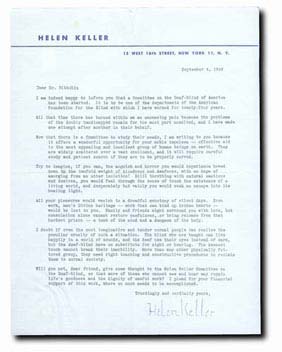Helen Keller

Inscribed and signed in bold pencil across her image,
To: Dr. Kronouet with cordial greetings...
July 1st, 1940.
At the age of 19 months, Helen Keller suffered an illness
that left her overwhelmingly deaf and blind. She overcame these disabilities
with the help of a dedicated teacher, Anne Sullivan, who taught Helen how to
read and write in Braille. Helen also learned to speak, excelled in her studies,
and graduated from Radcliff College in 1904.
After graduation from Radcliffe College in 1904, Keller
devoted herself to a range of social causes. 1909 she joined the Socialist
Party and the Industrial Workers of the World and devoted herself to a range of
social issues. In 1916 she campaigned against U.S. entry into World
War I. Helen also campaigned in favor of women's suffrage.
In 1924 Helen turned her attention to the American
Foundation for the Blind and became their national spokesperson. As a national
symbol of personal bravery in the face of adversity, her books, and William
Gibson's popular play, The Miracle Worker convinced the American people
that physical limitations need not compromise a person's intellectual potential.

In New York, Sep 4, 1948 Helen wrote
“...Try to imagine, if
you can, the anguish and horror you would experience bowed down by the twofold
weight of blindness and deafness, with no hope of emerging from an utter
isolation! Still throbbing with natural emotions and desires, you would feel
through the sense of touch the existence of a living world, and desperately but
vainly you would seek an escape into its healing light. All of your pleasures
would vanish in a dreadful monotony of silent days. Even work, man’s Divine
Heritage—work that can bind up broken hearts— would be lost to you. Family
and friends might surround you with love, but consolation alone cannot restore
usefulness, or bring release from that hardest prison— a tomb of the mind and
a dungeon of the body...”



























































